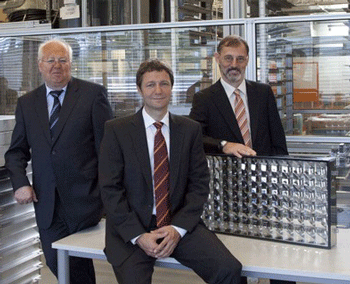- News
1 September 2011
Multi-junction CPV technology of Soitec, AZUR SPACE and Fraunhofer ISE nominated for German Future Prize
Hansjörg Lerchenmüller (senior VP at Soitec of Bernin, France), Dr Andreas Bett (deputy director of Fraunhofer Institute for Solar Energy Systems ISE in Freiburg and director of its Materials – Solar Cells and Technology Division) and Dr Klaus-Dieter Rasch (managing director of AZUR SPACE Solar Power GmbH in Heilbronn) have been nominated for the German Future Prize 2011. Together they have developed multi-junction concentrator photovoltaic (CPV) solar cells, modules and systems that capture different ranges of the solar spectrum, converting twice as much sunlight into electrical energy as silicon-based photovoltaic systems.
Each year, the jury of the German Future Prize nominates three teams that, due to excellence in research, have introduced new products to the market. The Federal President of Germany, Christian Wulff, attended the official nomination ceremony on 27 August at the IdeenExpo in Hannover and will present the award to the winning team on 14 December.
 Picture: Nominated for the German Future Prize 2011, from left to right: Dr Klaus-Dieter Rasch (managing director of AZUR SPACE Solar Power), Hansjörg Lerchenmüller (senior VP at Soitec), and Dr Andreas Bett (director of the materials – Solar Cells and Technology Division and deputy director of Fraunhofer ISE).
Picture: Nominated for the German Future Prize 2011, from left to right: Dr Klaus-Dieter Rasch (managing director of AZUR SPACE Solar Power), Hansjörg Lerchenmüller (senior VP at Soitec), and Dr Andreas Bett (director of the materials – Solar Cells and Technology Division and deputy director of Fraunhofer ISE).
Currently, 85% of all photovoltaic modules are made using crystalline silicon. However, this only converts a specific range of the solar spectrum into electrical energy, so efficiency is limited. Hence, 15 years ago, researchers at Fraunhofer ISE targeted finding a new approach: depositing several layers of various semiconductors — specifically, the III-V semiconductors gallium indium phosphide (GaInP), gallium indium arsenide (GaInAs) and germanium (Ge) — on top of each other in one solar cell, just 3mm in diameter. “Each semiconductor captures a different range of the solar spectrum and the energy yields add up,” says Bett.
Multi-junction solar cells were initially developed for space applications. The III-V solar cells developed at Fraunhofer ISE are manufactured industrially by AZUR SPACE and used to supply energy for telecom satellites. However, the firm also produces multi-junction solar cells for terrestrial applications. Fraunhofer ISE’s III-V solar cells have an efficiency of 41.1% (a record in 2009) and are currently being transferred to series production by AZUR SPACE. “Within a very short period of time we were able to show that efficiencies of 40% are possible in the solar industry, and we believe that those around the 50% mark are also entirely feasible,” says Rasch.
To exploit the potential of multi-junction solar cells for terrestrial applications, researchers at Fraunhofer ISE focused on optical concentration. Lenses that concentrate sunlight by a factor of 500 were placed in front of the multi-junction solar cells, and cells and lenses were then combined into one module. “We have replaced expensive semiconductor materials and added low-cost lenses. Thanks to these newly developed concentrator modules, we are able to produce a higher output per area,” says Bett.
After developing the module in the laboratory, in order to develop production-ready concentrator modules and convert them into high-performance systems, staff at Fraunhofer ISE founded the spin-off firm Concentrix Solar GmbH under the direction of Lerchenmüller. The company continued to drive the industrial processing technology that had been initiated at Fraunhofer ISE and, after a few years, launched Concentrix Modules on the market. The firm was acquired in December 2009 by Soitec Group, which manufactures engineered substrates including silicon-on-insulator (SOI) wafers (as well as III-V epiwafers through its Picogiga International division).
“Our concentrator modules convert 28% of sunlight into electricity, that’s twice as much as in conventional photovoltaics,” says Lerchenmüller. In addition to their lower energy-generation costs, concentrator systems have further advantages: Due to their modular design they can be used in power plants with energy outputs ranging from less than 1MW to more than 100MW. The energy needed to manufacture the modules is paid back after just a few months of operation, and the investment costs required to set up mass-production facilities are comparatively low, it is claimed.
Concentrator technology is well suited to large-scale solar power plants in sunny regions. Soitec Solar has already installed more than 3MW of capacity in power plants in Southern Europe, South Africa and the USA, and will soon build another module factory in the USA.
www.deutscher-zukunftspreis.de
